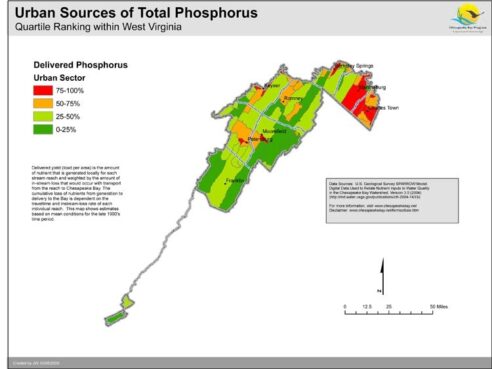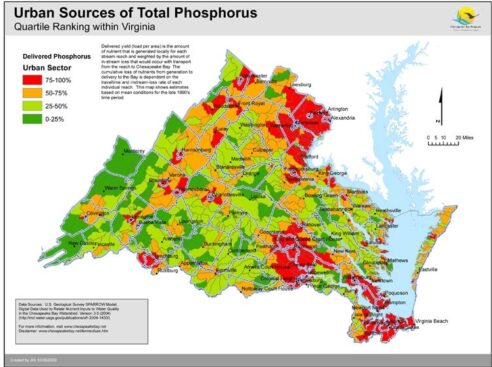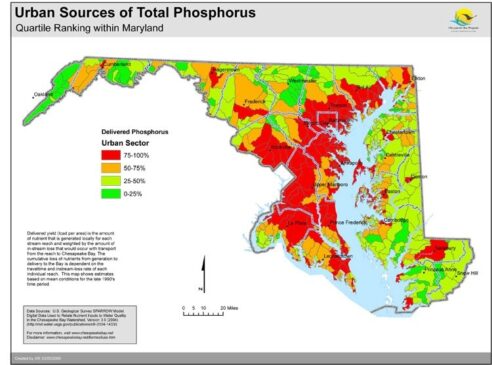Maps
Browse through maps depicting Bay health and restoration, including pollution trends, public access sites and more.
Long-Term Flow-Adjusted Trends for Total Phosphorus (32 Sites in the Chesapeake Bay Watershed)
Date created: June 25, 2012Long-Term Flow-Adjusted Trends for Total Phosphorus (32 Sites in the Chesapeake Bay Watershed) 1985-2009
View mapPhosphorus Yields and Short-Term Trends Measured in Watershed Streams and Rivers
Date created: June 13, 2012Over the past 10 years, phosphorus concentration trends are not significant at more than half (19 of 33) monitoring sites within the Bay watershed. Improving trends were estimated at 10 sites while degrading conditions were reported at 4 sites, indicating that in some locations, management actions, such as improved wastewater treatment and nonpoint-source pollution controls (i.e. urban stormwater runoff and agricultural runoff controls), have reduced phosphorus concentrations in streams. The short-term flow-adjusted trends and yields indicator is calculated, and results and maps are published annually by the U.S. Geological Survey as part of a larger effort to determine loads and trends in nutrient and sediment concentrations and streamflow in the Chesapeake Bay watershed.
View mapLong-Term Flow-Adjusted Trends Total Phosphorus (32 Sites in the Chesapeake Bay Watershed) 1985-2009
Date created: March 11, 2011Over the past 24 years, phosphorus concentration trends are downward at the majority of long-term monitoring sites within the Bay watershed. The trend results indicate that in many locations, management actions, such as improved wastewater treatment and nonpoint-source pollution controls (i.e. urban stormwater runoff and agricultural runoff controls), have reduced phosphorus concentrations in streams. The flow-adjusted trends indicator is calculated, and published annually by the U.S. Geological Survey as part of a larger effort to determine loads and trends in nutrient and sediment concentrations and streamflow in the Chesapeake Bay watershed. A complete description of data analysis methods can be found in Langland, M. J., and others, Changes in streamflow and water quality in selected nontidal basins in the Chesapeake Bay watershed, 1985-2004: U.S. Geological Survey Scientific Investigations Report 2006-5178, 75 p., available online at http://pubs.usgs.gov/sir/2006/5178/
View mapPhosphorus Yields and Short-Term Trends Measured in Watershed Streams and Rivers
Date created: March 10, 2011Over the past 10 years, phosphorus concentration trends are not significant at more than half (19 of 33) monitoring sites within the Bay watershed. Improving trends were estimated at 10 sites while degrading conditions were reported at 4 sites, indicating that in some locations, management actions, such as improved wastewater treatment and nonpoint-source pollution controls (i.e. urban stormwater runoff and agricultural runoff controls), have reduced phosphorus concentrations in streams. The short-term flow-adjusted trends and yields indicator is calculated, and results and maps are published annually by the U.S. Geological Survey as part of a larger effort to determine loads and trends in nutrient and sediment concentrations and streamflow in the Chesapeake Bay watershed.
View mapUrban Sources of Total Phosphorus - Quartile Ranking within New York
Date created: March 5, 2009This map shows a quartile ranking within New York of the delivered yield (load per area) of Total Phosphorus from urban sources. Delivered yield is the amount of nutrient that is generated locally for each stream reach and weighted by the amount of in-stream loss that would occur with transport from the reach to Chesapeake Bay. The cumulative loss of nutrients from generation to delivery to the Bay is dependent on the travel time and instream-loss rate of each individual reach. This map shows estimates of Total Phosphorus based on mean conditions for the late 1990's time period using the SPARROW model from USGS. SPARROW, or SPAtially Referenced Regressions On Watershed (SPARROW) attributes, uses a nonlinear regression approach to spatially relate nutrient sources and watershed characteristics to nutrient loads of streams throughout the Chesapeake Bay watershed.
View mapUrban Sources of Total Phosphorus - Quartile Ranking within Delaware
Date created: March 5, 2009This map shows a quartile ranking within Delaware of the delivered yield (load per area) of Total Phosphorus from urban sources. Delivered yield is the amount of nutrient that is generated locally for each stream reach and weighted by the amount of in-stream loss that would occur with transport from the reach to Chesapeake Bay. The cumulative loss of nutrients from generation to delivery to the Bay is dependent on the travel time and instream-loss rate of each individual reach. This map shows estimates of Total Phosphorus based on mean conditions for the late 1990's time period using the SPARROW model from USGS. SPARROW, or SPAtially Referenced Regressions On Watershed (SPARROW) attributes, uses a nonlinear regression approach to spatially relate nutrient sources and watershed characteristics to nutrient loads of streams throughout the Chesapeake Bay watershed.
View map
Urban Sources of Total Phosphorus - Quartile Ranking within West Virginia
Date created: March 5, 2009This map shows a quartile ranking within West Virginia of the delivered yield (load per area) of Total Phosphorus from urban sources. Delivered yield is the amount of nutrient that is generated locally for each stream reach and weighted by the amount of in-stream loss that would occur with transport from the reach to Chesapeake Bay. The cumulative loss of nutrients from generation to delivery to the Bay is dependent on the travel time and instream-loss rate of each individual reach. This map shows estimates of Total Phosphorus based on mean conditions for the late 1990's time period using the SPARROW model from USGS. SPARROW, or SPAtially Referenced Regressions On Watershed (SPARROW) attributes, uses a nonlinear regression approach to spatially relate nutrient sources and watershed characteristics to nutrient loads of streams throughout the Chesapeake Bay watershed.
View map
Urban Sources of Total Phosphorus - Quartile Ranking within Virginia
Date created: March 5, 2009This map shows a quartile ranking within Virginia of the delivered yield (load per area) of Total Phosphorus from urban sources. Delivered yield is the amount of nutrient that is generated locally for each stream reach and weighted by the amount of in-stream loss that would occur with transport from the reach to Chesapeake Bay. The cumulative loss of nutrients from generation to delivery to the Bay is dependent on the travel time and instream-loss rate of each individual reach. This map shows estimates of Total Phosphorus based on mean conditions for the late 1990's time period using the SPARROW model from USGS. SPARROW, or SPAtially Referenced Regressions On Watershed (SPARROW) attributes, uses a nonlinear regression approach to spatially relate nutrient sources and watershed characteristics to nutrient loads of streams throughout the Chesapeake Bay watershed.
View map
Urban Sources of Total Phosphorus - Quartile Ranking within Pennsylvania
Date created: March 5, 2009This map shows a quartile ranking within Pennsylvania of the delivered yield (load per area) of Total Phosphorus from urban sources. Delivered yield is the amount of nutrient that is generated locally for each stream reach and weighted by the amount of in-stream loss that would occur with transport from the reach to Chesapeake Bay. The cumulative loss of nutrients from generation to delivery to the Bay is dependent on the travel time and instream-loss rate of each individual reach. This map shows estimates of Total Phosphorus based on mean conditions for the late 1990's time period using the SPARROW model from USGS. SPARROW, or SPAtially Referenced Regressions On Watershed (SPARROW) attributes, uses a nonlinear regression approach to spatially relate nutrient sources and watershed characteristics to nutrient loads of streams throughout the Chesapeake Bay watershed.
View map
Urban Sources of Total Phosphorus - Quartile Ranking within Maryland
Date created: March 5, 2009This map shows a quartile ranking within Maryland of the delivered yield (load per area) of Total Phosphorus from urban sources. Delivered yield is the amount of nutrient that is generated locally for each stream reach and weighted by the amount of in-stream loss that would occur with transport from the reach to Chesapeake Bay. The cumulative loss of nutrients from generation to delivery to the Bay is dependent on the travel time and instream-loss rate of each individual reach. This map shows estimates of Total Phosphorus based on mean conditions for the late 1990's time period using the SPARROW model from USGS. SPARROW, or SPAtially Referenced Regressions On Watershed (SPARROW) attributes, uses a nonlinear regression approach to spatially relate nutrient sources and watershed characteristics to nutrient loads of streams throughout the Chesapeake Bay watershed.
View map
